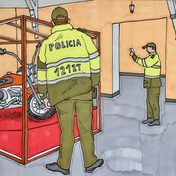
Part of the Narcoaesthetics project developing at the University of Los Andes in Bogotá, Colombia, X. Andrade and Esteban Borrero’s “Narcolombia” is a series of ethnographic drawings that contemplate a curatorial scene. The Narcoaesthetics Project is a necessary intervention that directly confronts the problems, stigmas, and fascinations with narco-culture and aesthetics in Colombia (see also interview with Andrade). The particular scenes contemplated in “Narcolombia” take place in the Historical Museum of National Police in downtown Bogotá (see Krauss et al. 2017). The scenes drawn appear quite straightforward at first glance: people’s relation to a certain object in the museum. They center on a particular room as part of the curated tours in the museum. The “crime doesn’t pay” room is home to a set of belongings confiscated from the Colombian drug cartels, including mafia leader, Gonzalo “El Mexicano” Rodríguez Gacha’s gun collection and a Harley Davidson motorbike gifted by Pablo Escobar to one of his hitmen.
Through image and text, “Narcolombia” curates a curatorial collapse. The confiscated motorbike safely guarded behind the glass stand disrupts the curatorial order. This moment in the police guided tour is one of transgression where the frailty of order and mastery over the so-called criminal underworld becomes revealed. I’m reminded of the opening image-scene from Daniella Gandolfo’s (2009) The City at Its Limits, where an older protester in Lima’s main downtown plaza exposes her breast and collapses the social order. What these two arresting scenes have in common is that they demonstrate that capacity for ordinary transgressions to “upset a deeply embedded regime of law lurking beyond the law” (Gandolfo 2009: xii). The allure, fascination, and the selfie to document this moment, all fracture the momentum and authority of the police-curator. The auratic charge of the motorbike leaks out of the glass stand and invites other kinds of relations to emerge.
But why would the national police want to showcase to the public the confiscated material from the drug cartels and the broader criminal underworld (which, fittingly, is exhibited in the basement floor of the museum), if not to make claims about conquering the cartels. That is, to fashion themselves as the conquistadores of marvelous and fantastical netherworlds. Worlds that are as materially real as they are phantasmatic. To literally tame the cartel’s material culture in glass stands and rooms as though this curation wasn’t only for the public but also for the state to itself. As though through the curation of the cartel’s material culture, the state becomes empowered by the seizure and consumption of their opponent’s mystical aesthetics.
And so although Borrero's drawings seem straightforward as noted, for me, they point toward this something else beyond the image through the image. The images of “De Pablo para el Arete” are good to think with for Con-text-ure since they are in-sights drawn from an embodied positionality that “transduce” (see Myers 2020) the auratic and affective appeal found through encounter and transgression. Drawing is perhaps a practice of slowing down; it tries to arrest the shards of a fleeting image or sensation that arrested the drawer in the first place. Therefore, I take these set of drawings not so much as a form of realist capture in ethnographic research, but as a way to place a hold, a momentary suspension on these scenes that try to reckon with the once felt auratic charge in a room.
But where does this magnetizing force that engenders “curatorial collapse” and allure come from? What is the underside of this glamorous motorbike with silver and gold engravings? I take cues from Michael Taussig’s (2012) Beauty and the Beast, another undertaking on the question of narcoaesthetics in Colombia, in order to understand this appeal through the relation between glamour and horror. As Taussig makes the connection, beauty is always linked to the horrific—which in this case, the appeal is perhaps directly from the horrific since the glamorous motorbike is the material remains of war and terror waged by the cartels in Colombia. By drawing this encounter of disorder, the images for me come to indirectly approximate the “negative sacred” (Taussig 2011)—or the charged moment found in these scenes, that derives from the violence and horror that is associated with the glamorous narcoaeshetic.
References
Gandolfo, Daniella. 2009. The City at Its Limits: Taboo, Transgression, and Urban Renewal in Lima. Chicago: University of Chicago Press.
Krauss, Daniel, X. Andrade, Ana María Forero, and Mauricio Salinas. 2017. "Rótulos, Etnografía y Curadorías en el Museo Histórico de la Policía Nacional, Bogotá." Íconos 59: 165–82.
Myers, Natasha. 2020. "Anthropologist as Transducer in a Field of Affects." In Knots and Knowings: Methodologies and Ecologies in Research-Creation, edited by Natalie Loveless, 97–126. Edmonton: University of Alberta Press.
Taussig, Michael. 2011. I Swear I Saw This: Drawings in Fieldwork Notebooks, Namely my Own. Chicago: University of Chicago Press.
———. 2012. Beauty and the Beast. Chicago: University of Chicago Press.
Posts in This Series

Narcolombia: Ensamblaje y Colapso Curatorial en un Museo / Narcolombia: Assemblage and Curatorial Collapse in a Museum
Read the English Translation Narcolombia: Ensamblaje y Colapso Curatorial en un Museo Este ensayo experimenta con dos temporalidades distintas: la de la etnogra... More